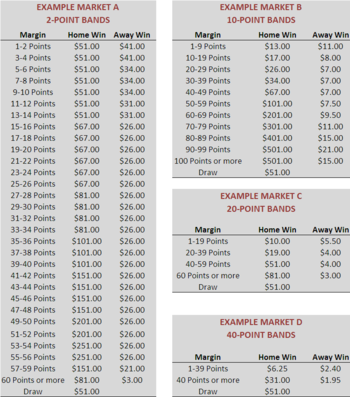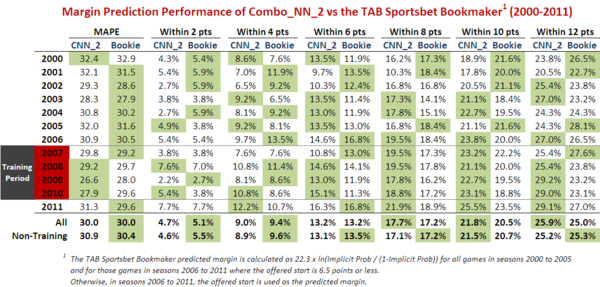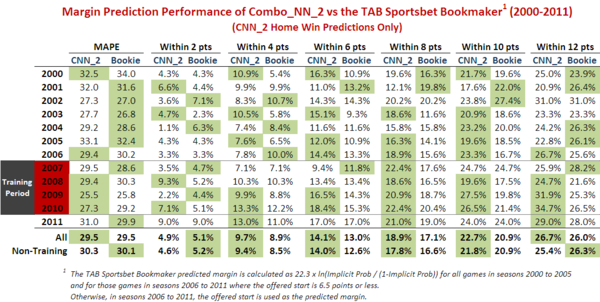2012 : Breaking With Tradition (Just a Little) - Part II
 Sunday, January 8, 2012 at 3:51PM |
Sunday, January 8, 2012 at 3:51PM |  Post a Comment
Post a Comment In the previous blog I described how the revamped Line and Head to Head Funds will operate in 2012 and mentioned that MAFL would be venturing into a new market type, the margin market, partly to satisfy my need for change and variety, and partly as an insurance policy should head to head wagering continue to prove unprofitable. Reanalysing results for the past 5 years strongly suggests that there was something different about the head to head markets in 2011, that some qualitative change took place that rendered modelling approaches that would have been successful in earlier years impaired or impotent.
There were, of course, some obvious changes last season that might explain this: the launch of the Gold Coast and the upset that caused to the pre-season drafting process, the introduction of the bye, and a handful of rule amendments and interpretations. Only hindsight will reveal if these were the real culprits, but I wonder if the increasingly competitive nature of the Australian wagering market has also been a factor and has driven out some of the inefficiencies in the pricing of the head to head markets that existed in seasons past.
So, with that possibility in mind I've decided to ease MAFL into the margin market where I'm hoping that some inefficiencies might remain.
Let's start by reviewing the options offered to us by the TAB Sportsbet bookmaker.
The table below shows the TAB Sportsbet margin markets for the Roos v Collingwood game of Round 16 of last season. (Please click it for a larger version.)
 There are, as you can see, 4 margin markets, differing only in the manner in which they group potential victory margins. The market with the finest margin gradations uses mostly 2-point bands, while the other markets use mostly 10-point bands, mostly 20-point bands, and mostly 40-point bands respectively.
There are, as you can see, 4 margin markets, differing only in the manner in which they group potential victory margins. The market with the finest margin gradations uses mostly 2-point bands, while the other markets use mostly 10-point bands, mostly 20-point bands, and mostly 40-point bands respectively.
Though not immediately obvious from these tables, the overround in each market rises sharply with the number of wagers offered. In the 2-point market, which offers 61 distinct wagers, the overround is a usurious 78%; in the 10-point market with 23 options, it's still an alarming 42%; in the 20-point market with 9 options, it's 22%, and in the 40-point market, which provides 5 possible wagers, it's just 14%.
All of these overround percentages are considerably larger than the the roughly 7% we generally face in head to head wagering and the 5.3% we confront in line wagering.
If we assume that the TAB Sportsbet bookmaker levies overround approximately equally on all wagers then, for any wager to have a positive expectation, we'd need it to be significantly mispriced, especially in the 2-point market where the bookie has gifted himself an almost 80% buffer. That means, for example, that he could afford to assess a true 5% chance as a 3% chance and still enjoy a positive expectation.
The maths for this example works as follows:
- A 3% chance would carry a fair price of $33.33
- Incorporating the overround of 80% shrinks this to $18.52 (ie $33.33/1.8)
- Taking this bet, assuming that the true probability is 5%, yields an expected return of 5% x $18.52 for the punter, which is about a 92.6c in the dollar return.
If the bookie does, indeed, levy overround approximately equally, this would be a compelling reason to stay out of these markets. But this assumption is by no means a given - we've previously detected, for example, suggestions of a favourite-longshot bias in the head to head markets for at least some seasons, which implies that longshots carried more of the overround in these markets in those years than did the favourites.
A similar favourite-longshot bias in margin markets would mean that the larger prices in these markets would incorporate a disproportionate share of the huge overrounds described above, creating the possibility that lower-priced wagers could still offer value with smaller mispricing by the bookie. Some evidence for the hypothesis that overround is a progressive tax on risk-seeking behaviour in margin markets comes from the fact that the markets with more options and greater total overround also have a greater proportion of longshot wagers. For example, in the 2-point market above, 31 of the 61 wagers are priced at over $50, whereas in the 40-point market, only 1 of the 5 wagers is priced in this range.
So, wagering in the margin markets might not be sheer folly, but it'd probably a good idea to generally avoid the longshot wagers unless you're convinced they're horrendously mispriced.
Which Market and Which Fund Algorithm?
So then, if we're to play in a margin market, which one?
After consideration, both due and undue, I've decided that we'll play in the 10-point market. The 2-point market, in light of the foregoing discussion about overround and longshots, pretty much rules itself out. There's high-priced, potentially overround-ridden wagers wherever you look. The 20-point and 40-point markets do have their attractions - lower overround the foremost among them - but I can foresee us making a series of wagers in the $2 to $5 price range if we play in either of those markets, and I reckon we'll have enough of that sort of action in our head to head wagering. As unscientific as that explanation might sound (and, well, frankly is), the 10-point market it is.
Having chosen a market we next need to select a Fund algorithm. Perhaps I can be truer to MAFL's data-driven philosophy in making this selection.
You might recall that the Combo_NN_2 Margin Predictor from last season seemed particularly good at tipping margins that were within about a goal of the eventual result. During the off-season I've run this model for all games in the past 12 seasons, the results of which appear below.
Bearing in mind that the neural net that powers CNN_2 was created using the data for the seasons 2007 to 2010 and was designed to minimise the MAPE across those seasons, the strong MAPE performance of CNN_2 relative to the TAB Sportsbet bookmaker in those seasons, as shown in the leftmost columns, is to be expected. Outside the training window, the TAB bookmaker prevails on this measure for every season but 2000.
The remaining columns compare the performances of CNN_2 and the TAB in terms of the percentage of games in which their respective margin predictions are "close" to the final result, for varying definitions of proximity. CNN_2 fares much better on these metrics. For example, its performance exceeds that of the TAB in terms of predicting a margin within 4 points of the final results in 4 of the 8 seasons excluding those in the training period, and it repeats this performance when the metric is, instead, predicting within 6 points.
Using the 8-point metric, CNN_2 is pipped 4-and-a-half seasons to 3-and-a-half, but its overall perfomance across these 8 seasons (17.1%) is almost identical to the TAB's. For the 10-point metric, CNN_2 splits the seasons 4-all, but has a superior overall percentage (21.5%) across all non-training seasons.
All of which is enough to suggest that CNN_2 shouldn't embarrass itself in margin prediction.
How the Fund Will Work
It's always been slightly unedifying to me when we've had active Funds that can bet either side of a contest and we find ourselves with wagers on both teams such that we win, and we lose, regardless of the result. That feeling of disquiet, along with the fact that the exploitable opportunities in MAFL have always tended to come from home teams, led me when considering the implementation practicalities for the Margin Fund, to rerun the earlier analysis looking only at those games where CNN_2 was tipping a home team victory. Herewith the results:
It was with much relief and some surprise that I discovered the relative performance of CNN_2 was considerably higher for these games. Rule 1 then is that the Margin Fund will only wager on those games where CNN_2 predicts a home team victory. That won't completely avoid the situation where we've conflicting bets - since the Line Fund might want a 25 point win or more for the Home team, whereas the Margin Fund needs a 10-19 point win - but it will reduce the potential for this situation.
Rule 2 is that the Margin Fund will wager 2.5% of the Fund on that score band into which CNN_2's predicted home team victory margin, rounded to the nearest integer, falls. So, for example, if CNN_2 tips the home team to win by 11.4 points, the Margin Fund would wager 2.5% on the Home Team by 10-19 points option. If CNN_2 instead tipped the home team by 19.6 points, the wager would be on the Home Team by 20-29 points option (since 19.6 rounds to 20). Mainly for the thrill of it, I'm also going to allow the Margin Fund to wager on the Draw option if CNN_2's predicted margin rounds to zero. Longshot bias be damned (for this wager type anyway).
Rule 3 is that the Margin Fund commences in Round 1. Further analysis, the results of which I'll not show here for reasons of brevity, finds no evidence of any improvement in the margin prediction skills of CNN_2 if, for example, the first 5 rounds of each season are excluded.
With these rules in force I'd expect that the Margin Fund would wager in about 50% of games and that it would wager:
- In the same victory margin band as the bookmaker's prediction about 29% of the time
- In the next higher band (from a home team perspective) 28% of the time (eg the Bookmaker is predicting a 7 point win by the Home team, which is in the 1-9 point band, while CNN_2 has the Home team winning by 15.3 points, which is in the 10-19 point band)
- In the band two higher (from a home team perspective) 16% of the time
- In the band three higher (from a home team perspective) 3% of the time
- In the next lower band (from a home team perspective) 21% of the time
- In the band two lower (from a home team perspective) 2% of the time
- On a draw about 5% of the time
As I don't have historical price data for the margin markets I can't assess how profitable or otherwise this Fund would have been in seasons past. Accordingly I'm going to run the Fund for the first 12 rounds of the season (or until its price goes to zero, whichever comes sooner) and, at that point, if its price is below 50c, terminate the Fund and transfer the remaining balance equally to the Head to Head and the Line funds.
That's it then - the Funds have been selected and defined.
In the next blog, I'll summarise the three Funds that'll be operating in 2012.
 TonyC |
TonyC | 



Reader Comments